
Needless to say, smart cities are springing up across the globe. Benefits of smart cities are manifold, chief among them security, sustainability and better mobility.
It goes without saying that urbanization is in full swing across the globe. As more and more people live in cities, certain issues inevitably arise, for example crime, traffic congestion and pollution. To better manage cities and reduce these problems, municipal administrators turn to smart city solutions, made possible by sensors and the data they generate.
In fact, the smart city market has increased in size as demands for relevant solutions rise. According to a report by Grand View Research, the global smart cities market is expected to reach US$237.6 billion by 2025, expanding at a compound annual growth rate of 18.9 percent from 2019 to 2025. “Demand for city solutions is anticipated to be on the rise, owing to a number of factors such as growing urban population and need to better manage limited natural resources and environmental sustainability. Rapid urbanization, aging infrastructure, and adoption of new technology, coupled with need for improved quality of life, are also driving the industry,” the report said.
So how does a smart city help municipal administrators achieve their objectives, in the process making the city more livable? In general, smart city benefits with the following three ways.
Security

Various IoT-based technologies from panic buttons to public address systems are deployed to enhance the security and safety of citizens. More and more, cities are relying on video surveillance, which today includes more advanced analytics to help detect and respond to crime. Irregular movements or objects can be spotted instantly and alerts sent.
Another video surveillance technology that has gained attention is facial recognition, which can help detect suspicious or blacklisted individuals immediately. More and more, the technology has gained acceptance among citizens as suggested by various polls.
Traffic management

Traffic management is also a key challenge for city officials, who can now turn to intelligent transportation systems (ITS) to make traffic smoother. Sensors such as inductive loops, radar and video surveillance can integrate with traffic signals to make them more adaptive. Advanced traffic management systems can help detect where traffic is heaviest and allow operators to deal with it immediately. With smart parking solutions, drivers can be alerted of where parking is available so they don’t have to waste time finding spaces.
Water/waste efficiency

The environment and sustainability are also important aspects of smart cities where officials are seeking to reduce pollution and optimize resources usage. In this regard, water and waste efficiency has become critical.
Many of the current problems facing water and waste efficiency include water losses from unknown leaks and blockages, water over-usage based on the amount required to finish the desired task at hand, unidentified inadequate water quality, energy consumption needed to move water and waste, as well as many others.
One solution that a smart water system would include are smart water grids, or SWGs, that ensure the security of water quantity and the safety of consumption. Another solution is smart water meters that, unlike manual meters, have a heightened ability to detect low water flow in pipes and potential backflow, which can lead to issues with how the system is operating. Lastly, smart pumps and valves can assess environmental conditions and signals from sensors and adjust their rate of activity accordingly. Variable speed pumps are able to take the data gained from sensors and either speed up or slow down depending on environmental conditions at the time.
Source: a&s Magazine



































































